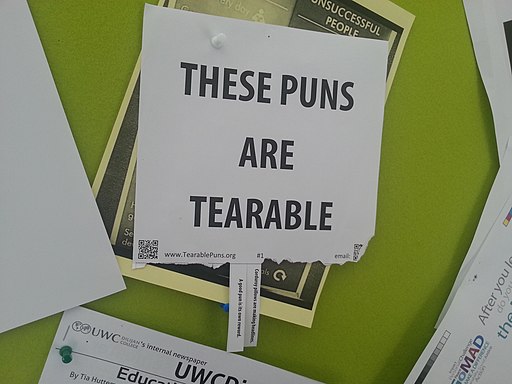A pun relies on wordplay with multiple meanings or similar sounds, while a joke is a humorous narrative or situation often unrelated to language play.
Understanding Puns

Puns are wordplay that involve a play on words, often utilizing homonyms, homophones, or similar sounding words to create a humorous effect. They rely on clever and creative linguistic techniques to create humor. Puns can be witty, clever, or even silly, making them a popular form of wordplay in various forms of communication.
To better understand puns, let’s explore their definition and examples:
- Definition of a Pun: A pun is a form of wordplay that exploits multiple meanings or the similar sounds of words to create humor.
- Examples of Puns: Some classic examples of puns include “I used to be a baker, but I couldn’t make enough dough,” and “Why don’t some couples go to the gym? Because some relationships don’t work out.”
Definition of a Pun
A pun, which is a form of wordplay, involves using multiple meanings or similar-sounding words to create humor or a play on words. It showcases a clever and witty use of language, often requiring the listener or reader to make a mental connection between the different meanings of the words used.
For instance, let’s consider the common pun “I used to be a baker, but I couldn’t make enough dough.” Here, the word “dough” has a double meaning – it can refer to the mixture used in baking as well as money. The pun relies on the similarity in sound between “dough” and “dough” to create a humorous twist.
Puns can be found in various forms of literature, jokes, advertising, and everyday conversations. They serve to add humor or a clever twist to a sentence or statement.
Interestingly, one of the earliest recorded puns can be traced back to ancient Egypt, dating back to the time of the pharaohs. This pun involved a play on words with the Egyptian god Amun and the Egyptian word for hidden or concealed (imn). The Egyptians expressed their appreciation for wordplay and wit by inscribing this pun on the walls of temples and tombs, even in their religious and funerary contexts. Puns have continued to evolve, entertaining people throughout history and proving that the art of wordplay is indeed a timeless source of enjoyment for cultures worldwide.
Examples of Puns
- Why don’t some couples go to the gym? Because some relationships don’t work out.
- I’m reading a book about anti-gravity. It’s impossible to put down!
- Why did the scarecrow win an award? Because he was outstanding in his field.
- Why don’t skeletons fight each other? They don’t have the guts.
- I used to be a baker, but I couldn’t make enough dough.
- Why did the bicycle fall over? Because it was two-tired.
- What do you call a snowman with a six-pack? An abdominal snowman.
- How does a penguin build its house? Igloos it together.
- Why did the tomato turn red? Because it saw the salad dressing!
- My friend’s bakery burned down last night. Now his business is toast.
Understanding Jokes

Jokes are a broader form of humor that can encompass various comedic techniques. Unlike puns, jokes often rely on narrative structure, surprise elements, and comedic timing to elicit laughter. Jokes can be in the form of one-liners, anecdotes, or riddles, and often have a setup and punchline.
To delve deeper into jokes, let’s explore their definition and examples:
-
- Definition of a Joke: A joke is a form of humor that uses a specific structure, which includes a setup and a punchline, to deliver its comedic effect.
- Examples of Jokes: Classic examples of jokes include “Why don’t skeletons fight each other? They don’t have the guts,” and “I told my wife she should embrace her mistakes. She hugged me.”
Definition of a Joke
A joke, in its simplest Definition of a Joke, is a form of humor or amusement that is intended to entertain or provoke laughter. Jokes often involve a play on words, clever wordplay, or a humorous narrative that leads to an unexpected punchline or funny conclusion. They can take various forms, such as one-liners, puns, riddles, or anecdotes.
The purpose of a joke is to evoke amusement and create a light-hearted atmosphere. Jokes rely on the surprise element, as they often involve an unexpected twist or clever wordplay that catches the listener off guard. They can be verbal, written, or visual, and are commonly used in social situations, comedy performances, or everyday conversations to entertain and engage others.
Jokes can serve multiple functions, including providing entertainment, easing tension, fostering connection, or conveying a message indirectly. They rely on linguistic skill to create humor through clever wordplay, puns, or misinterpretation.
It is important to note that the effectiveness of a joke can vary depending on cultural context, language, and individual sense of humor. What may be seen as funny in one culture or language may not have the same impact in another.
A joke is a form of humor that employs clever wordplay, unexpected twists, or humorous narratives to entertain and provoke laughter. It is a versatile tool used for entertainment, social interaction, and conveying messages in an indirect and humorous way.
Examples of Jokes
- Why don’t scientists trust atoms? Examples of Jokes
- Because they make up everything! Examples of Jokes
- Why did the scarecrow win an award? Examples of Jokes
- Because he was outstanding in his field! Examples of Jokes
- Why couldn’t the bicycle stand up by itself? Examples of Jokes
- Because it was two-tired! Examples of Jokes
- Why don’t skeletons fight each other? Examples of Jokes
- Because they don’t have the guts! Examples of Jokes
- Why don’t eggs tell jokes? Examples of Jokes
- Because they might crack up! Examples of Jokes
What Makes Puns Different from Jokes?
While both puns and jokes are forms of humor, they differ in various aspects:
- Wordplay vs. Narrative: Puns primarily rely on wordplay and clever language manipulation to create humor, while jokes often involve a narrative structure with a setup and punchline.
- Intentional Misinterpretation vs. Surprise: Puns often involve intentional misinterpretation or exploiting multiple meanings of words, whereas jokes often rely on unexpected twists or surprise elements.
Wordplay vs. Narrative
In the realm of wordplay vs. narrative, puns and jokes display distinctive characteristics. Puns rely heavily on wordplay, using multiple meanings of words or similar-sounding words to create humor. They often involve clever twists and play on words. For example, “I used to be a baker, but I couldn’t make enough dough,” showcases the wordplay involved in a pun.
In contrast, jokes tend to focus more on narrative structure and storytelling. They typically have a setup and a punchline, with the humor derived from the unexpected or ironic ending. Jokes may incorporate wordplay, but it is not the central aspect. An example of a joke is, “Why don’t scientists trust atoms? Because they make up everything!”
While both puns and jokes aim to entertain and elicit laughter, their approaches differ. Puns excel in exploiting linguistic nuances and cleverly manipulating words, providing quick and witty amusement. Jokes, on the other hand, captivate through engaging narratives and surprise endings, keeping the audience engaged until the punchline.
Understanding the distinction between wordplay and narrative can help individuals decide which comedic approach best suits their audience or situation. Whether it’s embracing the cleverness of puns or the storytelling of jokes, knowing the difference allows for a more nuanced appreciation of humor.
Intentional Misinterpretation vs. Surprise
When it comes to puns and jokes, intentional misinterpretation and surprise are important elements that set them apart. Here are some key points to understand the difference between intentional misinterpretation and surprise:
Intentional Misinterpretation: Puns often rely on intentional misinterpretation of words or phrases. By playing with multiple meanings or similar sounds, puns create humor through clever wordplay. This deliberate misinterpretation allows for a humorous twist that can catch the audience off guard and make them chuckle.
Surprise: Jokes, on the other hand, often rely on surprise. They build up a narrative or situation that leads the listener in one direction, only to deliver an unexpected punchline or twist at the end. This surprise factor is what generates laughter as it catches people off guard and surprises them with an unexpected outcome.
By incorporating intentional misinterpretation, puns add a clever twist to words and phrases, creating a humorous effect. On the contrary, jokes use surprise to deliver a funny payoff, often subverting expectations and taking the listener by surprise. Understanding these distinctions helps us appreciate the different ways puns and jokes generate humor through intentional misinterpretation and surprise.
Linguistic Skill vs. Delivery
Linguistic skill and delivery are the two critical components that make puns and jokes successful. Linguistic skill refers to the ability to creatively play with words, craft clever wordplay, and use language effectively. On the other hand, delivery encompasses the timing, tone, and presentation of the pun or joke.
In the realm of puns, linguistic skill takes precedence because the humor relies on the clever manipulation of words with multiple meanings or similar sounds. A skilled punster has the ability to create puns that are witty, clever, and intellectually satisfying. Their linguistic skill is evident through their playful and creative approach to constructing puns.
However, even the most skillful pun would fall flat without effective delivery. Delivery is an art that enhances the impact of a pun and brings out its humor. It involves factors such as timing, intonation, and gestures. A perfectly timed pun, delivered with impeccable skill, can greatly enhance its comedic effect.
When it comes to jokes, linguistic skill is also crucial, but delivery plays an even more significant role. A well-structured joke with a clever punchline can easily be spoiled if not delivered correctly. The delivery encompasses the comedian’s comedic timing, vocal expression, and body language. A skilled comedian knows how to build anticipation, pause for effect, and use gestures to elicit laughter from the audience.
When to Use Puns and Jokes?
Knowing when to use puns and jokes can help you effectively incorporate humor into your communication:
- Puns: Puns are wordplay that rely on multiple meanings of a word or words that sound similar but have different meanings. They are best used in situations where you want to add a clever and witty twist to your communication. Puns work well in casual conversations, social media posts, pun-based advertisements, and creative writing.
- Jokes: Jokes are structured humorous narratives or punchlines that rely on comedic timing and unexpected twists. They are best used when you want to elicit laughter and entertain a group of people. Jokes are commonly used in stand-up comedy, speeches, presentations, comedy writing, and informal social settings.
The decision to use puns or jokes depends on the context, audience, and purpose of your communication. Consider the following factors:
- Formality: Puns are generally more casual and can be used in informal settings. Jokes, on the other hand, can range from light-hearted and playful to more structured and professional, depending on the setting.
- Audience: Consider the preferences and sensibilities of your audience. Puns may be appreciated by those who enjoy wordplay and clever humor, while jokes may appeal to a wider range of people with varying comedic preferences.
- Objective: Determine the goal of your communication. Puns can be used to add a touch of humor and creativity to engage and entertain your audience. Jokes, with their structured format and punchlines, are better suited for generating laughter and creating a comedic effect.
- Effectiveness: Consider which form of humor will be most effective in achieving your desired outcome. Puns can be a subtle and clever way to humorously convey a message or idea. Jokes, with their setup and punchline, can generate immediate laughter and create a memorable impact.
Ultimately, whether you choose to use puns or jokes, remember to gauge the appropriateness of humor in the given situation and align it with your audience’s preferences and expectations.
Frequently Asked Questions
What is the difference between a pun and a joke?
A pun is a form of wordplay that uses multiple meanings or similar sounds of words for a humorous or rhetorical effect. It can involve homophonic, homographic, metonymic, or figurative language. On the other hand, a joke is a display of humor that uses words within a narrative structure to make people laugh, usually ending with a punchline.
How are puns and jokes different in terms of usage?
Puns are usually more obvious when spoken aloud, as pronunciation plays a significant role. Jokes, on the other hand, can have various adjectives applied to them, such as old, bad, inside, poor, silly, funny, lame, hilarious, stupid, or offensive.
Can you provide examples of puns?
Examples of puns include wordplay that confuses similar senses or sounds of words, such as “I used to be a baker, but I couldn’t make enough dough” or “I’m reading a book about anti-gravity. It’s impossible to put down!”
What are some examples of jokes?
Examples of jokes include amusing stories or situations that aim to make people laugh. They often involve a specific narrative structure with dialogue and end with a punchline. One example is: “Why don’t scientists trust atoms? Because they make up everything!”
How are puns and jokes used as forms of entertainment?
Puns are used by making or telling puns, while jokes are told or played. Both forms can provide entertainment and amusement to the audience.
Can puns and jokes also have figurative meanings?
Yes, puns and jokes can also have figurative meanings. Jokes can refer to the root cause or main issue, or describe something laughably worthless or far easier than expected. Similarly, puns can involve deliberately confusing similar definitions or sounds of words or phrases, or different definitions of the same word.
Image Credits
Featured Image By – gstudioimagen on Freepik
Image 1 By – Ijon, CC BY-SA 4.0 , via Wikimedia Commons
Image 2 By – WOLF LΔMBERT, CC0, via Wikimedia Commons









